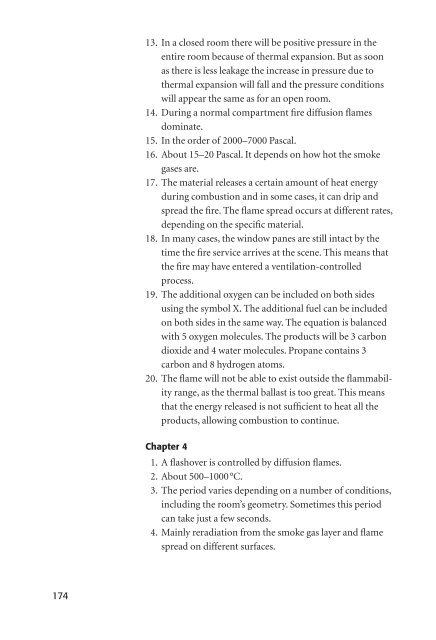Create successful ePaper yourself
Turn your PDF publications into a flip-book with our unique Google optimized e-Paper software.
174<br />
13. In a closed room there will be positive pressure in the<br />
entire room because of thermal expansion. But as soon<br />
as there is less leakage the increase in pressure due to<br />
thermal expansion will fall and the pressure conditions<br />
will appear the same as for an open room.<br />
14. During a normal compartment fi re diffusion fl ames<br />
dominate.<br />
15. In the order of 2000–7000 Pascal.<br />
16. About 15–20 Pascal. It depends on how hot the smoke<br />
gases are.<br />
17. The material releases a certain amount of heat energy<br />
during combustion and in some cases, it can drip and<br />
spread the fi re. The fl ame spread occurs at different rates,<br />
depending on the specifi c material.<br />
18. In many cases, the window panes are still intact by the<br />
time the fi re service arrives at the scene. This means that<br />
the fi re may have entered a ventilation-controlled<br />
process.<br />
19. The additional oxygen can be included on both sides<br />
using the symbol X. The additional fuel can be included<br />
on both sides in the same way. The equation is balanced<br />
with 5 oxygen molecules. The products will be 3 carbon<br />
dioxide and 4 water molecules. Propane contains 3<br />
carbon and 8 hydrogen atoms.<br />
20. The fl ame will not be able to exist outside the fl ammability<br />
range, as the thermal ballast is too great. This means<br />
that the energy released is not suffi cient to heat all the<br />
products, allowing combustion to continue.<br />
Chapter 4<br />
1. A fl ashover is controlled by diffusion fl ames.<br />
2. About 500–1000 °C.<br />
3. The period varies depending on a number of conditions,<br />
including the room’s geometry. Sometimes this period<br />
can take just a few seconds.<br />
4. Mainly reradiation from the smoke gas layer and fl ame<br />
spread on different surfaces.

















